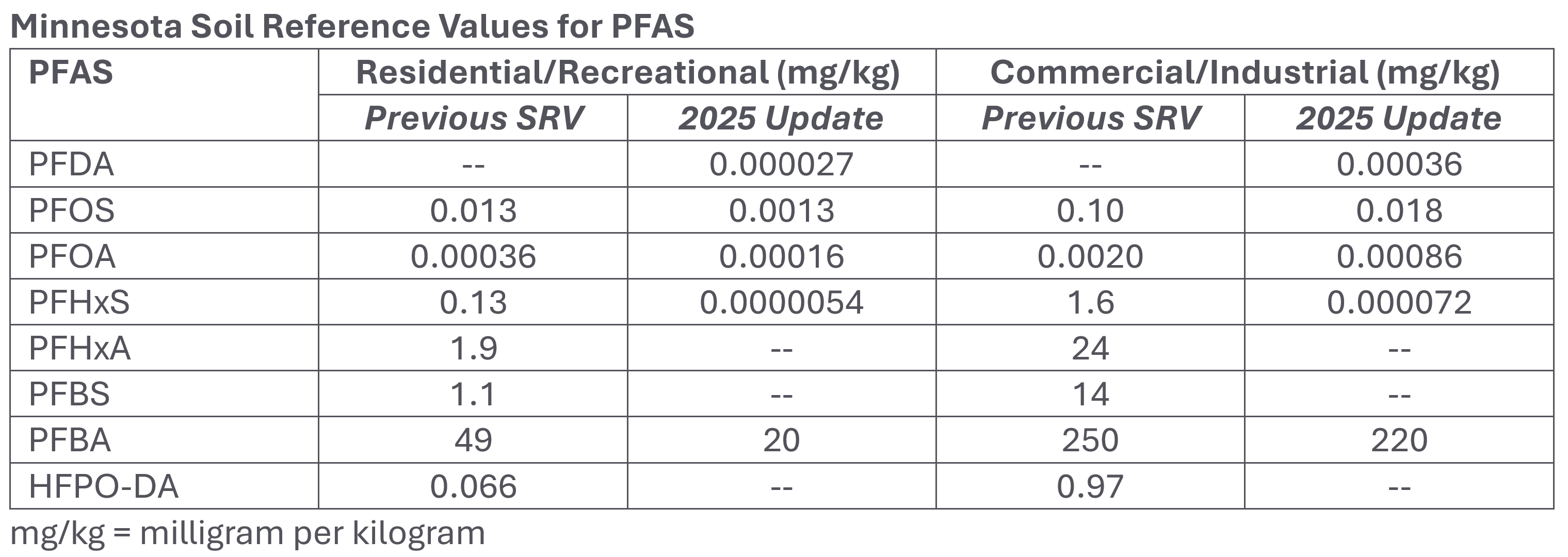
USEPA Releases Update on Children PFAS Exposure Research
The United States Environmental Protection Agency (USEPA) released an update on recent children’s health research on PFAS exposure conducted by the USEPA Office of Research and Development (ORD). In the study, ORD investigated the potential relationship between PFAS detected in house dust with PFAS detected in blood serum samples. The study utilized archived data from a National Children’s Study and reported that higher total PFOA levels in house dust were associated with higher total PFOA serum levels. The results also demonstrated that “exposure to PFAS via house dust may contribute up to 25% of total exposure for adults.”
Minnesota Updates Soil Reference Values for PFAS
In March 2025, the Minnesota Pollution Control Agency (MPCA) updated its Soil Reference Values (SRVs) for four PFAS and developed SRVs for one PFAS. SRVs are a screening tool that may be used to evaluate potential human health risks from exposure to contaminated soil. MPCA develops SRVs for two land use categories, residential/recreational and commercial/industrial. SRVs were updated for PFOS, PFOA, perfluorohexanesulfonic acid (PFHxS), and perfluorobutanoic acid (PFBA) and developed for perfluorodecanoic acid (PFDA) based on updated oral toxicity data. MPCA also has SRVs for hexafluoropropylene oxide dimer acid (HFPO-DA), perfluorohexanoic acid (PFHxA), and perfluorobutanesulfonic acid (PFBS). SRVs are included in the table below.

French Parliament Promulgates Law to Protect the Population from PFAS Related Risks
On February 27, 2025, the French Parliament promulgated Law No. 2025-188 intended to decrease public exposure to PFAS. The law enacts various bans, regulations, and action plans over the next few years, including the following:
- Ban the import, sale, and production of select PFAS-containing products, including cosmetics, non-protective clothing, and wax.
- Require the French Government to submit proposed updated health standards for PFAS in waters intended for human consumption to the French Parliament.
- Develop a trajectory plan to reduce aqueous discharges of PFAS from industrial facilities by enacting a fee for PFAS discharges exceeding a threshold of 100 grams per year.
- Adopt an interministerial action plan to finance drinking water treatment for PFAS.
- Require regional health agencies to create a public program to analyze for PFAS in water intended for human consumption, specifically bottled water.
Australia and New Zealand Publish Updated PFAS National Environmental Management Plan
In early 2025, the Heads of EPA Australia and New Zealand (HEPA) released the third update of its PFAS National Environmental Management Plan. The comprehensive guide for managing PFAS contamination was jointly developed by the Commonwealth, State, Territory, and HEPA. The updated plan provides guidance for PFAS investigation and risk assessment, remediation of contaminated land, and re-use of resource recovery products. It also includes risk-based criteria for re-using PFAS-contaminated biosolids.
Canadian Government Publishes State of PFAS Report and Releases Next Steps to Address PFAS
In March 2025, Environment and Climate Change Canada and Health Canada published a Final State of PFAS Report. The final report considered comments from both 60-day periods that followed the May 2023 and July 2024 drafts. The report summarizes the qualitative assessment of the fate, sources, occurrence, and potential impacts of PFAS on human health and the environment. The assessment was developed to inform decision-making on PFAS in Canada.
Additionally, on March 5, 2025, Environment and Climate Change Canada published a news release summarizing the steps the Government is taking to address PFAS and a Risk Management Approach for PFAS. The risk management approach recommends the addition of the class of PFAS, excluding polymers, to Part 2 of Schedule 1 to the Canadian Environmental Protection Act. This would prohibit the manufacture, use, sale, offer for sale, and import of PFAS. Currently PFOS, PFOA, long-chain perfluorocarboxylic acids, and their salts and precursors are prohibited. The risk management approach also details a phased approach to address various uses of PFAS.:
- Phase I, beginning in 2025, will prohibit PFAS used in firefighting foams.
- Phase II will prohibit PFAS used in products that are not required for the protection of human health, safety, or the environment such as cosmetics, food packaging materials, and textiles.
- Phase III will prohibit PFAS that require further evaluation of their role, which currently may not have feasible alternatives.
Additionally, the government will require manufacturing and other facilities to report PFAS use to the National Pollutant Release Inventory.
Geosyntec PFAS Webinar Series
Geosyntec hosted a PFAS webinar series showcasing a thorough synthesis of the state of knowledge on the management of PFAS-impacted sites. Subject matter experts from Geosyntec and the broader stakeholder community discussed key PFAS technical, regulatory, and legal issues.
To view webinar recordings of this six-part PFAS series as well as other archived PFAS webinars, visit Geosyntec PFAS Webinar Series.
Questions?
If you have any questions or would like to discuss how PFAS may impact your business, please email pfas@geosyntec.com to be connected with one of our PFAS technical experts.
